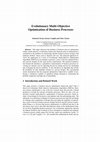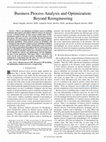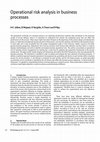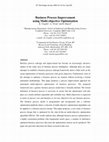Papers by Kostas Vergidis

This paper discusses the problem of business process optimisation within a multi-objective evolut... more This paper discusses the problem of business process optimisation within a multi-objective evolutionary framework. Business process optimisation is considered as the problem of constructing feasible business process designs with optimum attribute values such as duration and cost. The proposed approach involves the application of a series of Evolutionary Multi-objective Optimisation Algorithms (EMOAs) in an attempt to generate a series of diverse optimised business process designs for the same process requirements. The proposed optimisa-tion framework introduces a quantitative representation of business processes involving two matrices one for capturing the process design and one for calculating and evaluating the process attributes. It also introduces an algorithm that checks the feasibility of each candidate solution (i.e. process design). The experimental results demonstrate that the proposed optimisation framework is capable of producing a satisfactory number of optimised design alternatives considering the problem complexity and high rate of infeasibility.

The practice of optimising business processes has, until recently, been undertaken mainly as a ma... more The practice of optimising business processes has, until recently, been undertaken mainly as a manual task. This paper provides insights into an automated business process optimisation framework by using web services for the development of re-configurable business processes. The research presented here extends the framework of Vergidis (2008) by introducing web services as a mechanism for facilitating business process interactions, identifying enhancements to support business processes and undertaking three case studies to evaluate the proposed enhancements. The featured case studies demonstrate that an increase in the amount of available web services gives rise to improvements in the business processes generated. This research highlights an increase in the efficiency of the algorithm and the quality of the business process designs that result from the enhancements. Future research directions are proposed for the further improvement of the framework.

This paper presents results of extensive computational experiments in which evolutionary multiobj... more This paper presents results of extensive computational experiments in which evolutionary multiobjective algorithms were used to find Pareto-optimal solutions to a complex structural design problem. In particular, Strength-Pareto Evolutionary Algorithm 2 (SPEA2) was combined with a mathematical programming method to find optimal designs of steel structural systems in tall buildings with respect to two objectives (both minimized): the total weight and the maximum horizontal displacement of a tall building. SPEA2 was employed to determine Pareto-optimal topologies of structural members (topology optimization) whose cross-sections were subsequently optimized by the mathematical programming method (sizing optimization). The paper also presents the shape of the Pareto front in this two-dimensional objective space and discusses its dependence on the building's aspect ratio. The results reported provide both qualitative and quantitative knowledge regarding the relationship between the two objectives. They also show the trade-offs involved in the process of conceptual and detailed design of complex structural systems in tall buildings.

Studies in Computational Intelligence, 2007
Business process redesign and improvement have become increasingly attractive in the wider area o... more Business process redesign and improvement have become increasingly attractive in the wider area of business process intelligence. Although there are many attempts to establish a qualitative business process redesign framework, there is little work on quantitative business process analysis and optimization. Furthermore, most of the attempts to analyze and optimize a business process are manual without involving a formal automated methodology. Business process optimization can be classified as a scheduling problem, expressed as the selection of alternative activities in the appropriate sequence for the available resources to be transformed and thus satisfy the business process objectives. This chapter provides an overview of the current research about business process analysis and optimization and introduces an evolutionary approach. It demonstrates how a business process design problem can be modeled as a multi-objective optimization problem and solved using existing techniques. An illustrative case study is presented to demonstrate the results obtained through three multi-objective optimization algorithms. It is shown that multi-objective optimization of business processes is a highly constrained problem with fragmented search space. However, the results demonstrate a successful attempt and highlight the directions for future research in the area. www.springerlink.com © Springer-Verlag Berlin Heidelberg 2007 A. Tiwari et al.: Evolutionary Optimization of Business Process Designs, Studies in Computational Intelligence (SCI) 49, 513-541 (2007) A. Tiwari et al. A. Tiwari et al.
2008 IEEE Congress on Evolutionary Computation (IEEE World Congress on Computational Intelligence), 2008
Abstract This paper discusses the problem of business process design and attribute optimization w... more Abstract This paper discusses the problem of business process design and attribute optimization within a multi-objective evolutionary framework. Business process design and attribute optimization is considered as the problem of constructing feasible business ...
2008 IEEE Congress on Evolutionary Computation (IEEE World Congress on Computational Intelligence), 2008
Abstract This paper presents the concept of the evaluation line-a posteriori preference articulat... more Abstract This paper presents the concept of the evaluation line-a posteriori preference articulation approach for evaluating Pareto-optimal solutions using high level preference criteria. The evaluation line is an approach based on analytical geometry. It is sketched ...
2007 IEEE Congress on Evolutionary Computation, 2007
Proceedings of the Institution of Mechanical Engineers, Part B: Journal of Engineering Manufacture, 2008
ABSTRACT

International Journal of Production Economics, 2007
Most of the current attempts for business process optimisation are manual without involving any f... more Most of the current attempts for business process optimisation are manual without involving any formal automated methodology. This paper proposes a framework for multi-objective optimisation of business process designs. The framework uses a generic business process model that is formally defined and specifies process cost and duration as objective functions. The business process model is programmed and incorporated into a software platform where a selection of multi-objective optimisation algorithms is applied to a range of test designs including a real example. The test business process designs are of varying complexity and are optimised with three popular optimisation techniques (NSGA2, SPEA2 and MOPSO algorithms). The results indicate that although business process optimisation is a highly constrained problem with fragmented search space; multi-objective optimisation algorithms such as NSGA2 and SPEA2 produce a satisfactory number of alternative optimised business process designs. However, the performance of the optimisation algorithms drops sharply as the complexity of the process designs increases. This paper also discusses the directions for future research in this particular area.

International Journal of Production Economics, 2008
Business processes have been discussed for more than a decade now. However, there are not as of y... more Business processes have been discussed for more than a decade now. However, there are not as of yet comprehensive and substantial benefits that can justify the hype around the concept. This paper contrasts and summarises the main findings of literature research and a targeted survey conducted within the service industry in order to investigate the current state of research and practice regarding key aspects of business processes. The survey involved the participation of 25 respondents working in service industry sectors such as finance, public sector and consultancy. The paper demonstrates that although theoretical developments are dealing with sophisticated issues around business processes, the service industry is reluctant to adopt a similar perspective and still uses simple and manual techniques in dealing with business processes. The main reason is that the service industry is not convinced that a business process approach could bring significant tangible and measurable benefits. This is due to the fact that there is no comprehensive and systematic solution proposed in terms of a fully functional business process software suite. The requirements for an integrated business process management tool include some of the paper's findings. r
International Journal of Computer Integrated Manufacturing, 2013
International Journal of Computational Intelligence and Applications, 2004
For face recognition from video streams speed and accuracy are vital aspects. The first decision ... more For face recognition from video streams speed and accuracy are vital aspects. The first decision whether a preprocessed image region represents a human face or not is often made by a feed-forward neural network (NN), e.g., in the Viisage-FaceFINDER video surveillance system. We describe the optimization of such a NN by a hybrid algorithm combining evolutionary multi-objective optimization (EMO) and gradient-based learning. The evolved solutions perform considerably faster than an expert-designed architecture without loss of accuracy. We compare an EMO and a single objective approach, both with online search strategy adaptation. It turns out that EMO is preferable to the single objective approach in several respects.

IEEE Transactions on Systems, Man, and Cybernetics, Part C (Applications and Reviews), 2000
There is an abundance of business process modeling techniques that capture and address different ... more There is an abundance of business process modeling techniques that capture and address different aspects of a business process. A limited number of these process models allow further quantitative analysis, and only a few enable structured process improvement. This paper reviews and classifies the main techniques for business process modeling with regard to their analysis and optimization capabilities. Three primary groups are identified, and a selection of representative business process modeling techniques is classified based on these. Similar classification is also presented for the analysis and optimization approaches for business processes that were identified in relevant literature. The main contribution of the paper is that it identifies which types of business process models are suitable for analysis and optimization, and also highlights the lack of such approaches. This paper offers a state-of-the-art review in the areas of business process modeling, analysis, and optimization-underlining that the latter two have not received enough coverage and support in the literature.

Computers in Industry, 2008
Business strategy is currently largely defined by the way that an organisation interacts with its... more Business strategy is currently largely defined by the way that an organisation interacts with its stanapproach for supporting new product introduction (NPI) investments. The proposed methodology combines the existing concepts of directional policy matrix and real options are combined to establish the novel real options matrix (ROM) that enables strategic decisions regarding NPI. ROM consists of nine regions based on company's competitive capabilities and business sector prospects. To address the fuzzy boundaries between the ROM regions a fuzzy expert system is developed and validated based on a historical case study of a petrochemical industry. The results indicate that ROM can provide a reliable guide within the particular context as the strategy that the company followed matched with the ROM recommendation. The results are encouraging and support further consideration of ROM regarding NPI decisions. #

BT Technology Journal, 2007
The operational continuity of a business process is an important performance indicator that contr... more The operational continuity of a business process is an important performance indicator that contributes to the perceived quality of service delivery, hence it is important to understand and monitor the underlying issues that can affect the performance of the process. These issues might have been foreseen at the beginning of the process design and deployment phase, or might have emerged during the execution of the process, and must be viewed as risk threats to the business process. In most cases risk is only considered from the project management angle or from financial, market, insurance and other general business perspective. Operational risk at service provision level receives little attention and thus there is a need to develop methodologies and tools to identify and analyse business operational risks. The authors concentrate on operational risk for business process management by introducing a novel way for applying risk assessment frameworks at the process activity level. The paper briefly reviews existing risk frameworks and selects the COSO framework as the most appropriate for business processes. This framework is modified in order to address and evaluate the main elements of business processes. It defines a statistical approach towards operational risk assessment by quantifying risk factors in each activity within a business process for service provision. A risk forecast is produced for each activity, and for the whole process, to model associated uncertainties and to contribute in identifying the risk factors that affect the business process objectives. To demonstrate the framework, it is applied to a hypothetical process involving setting up a network service. These results help to advise on which risk factors need higher attention in order to achieve successful process fulfilment.

BT Technology Journal, 2006
Business process redesign and improvement has become an increasingly attractive subject in the wi... more Business process redesign and improvement has become an increasingly attractive subject in the wider area of business process intelligence. Although there are many attempts to establish a business process redesign framework, there is little work on the actual optimisation of business processes with given objectives. Furthermore, most of the attempts to optimise a business process are manual without involving a formal automated methodology. This paper proposes a process improvement approach for automated multi-objective optimisation of business processes. The proposed framework uses a generic business process model that is formally defined. The formal definition of business process is necessary to ensure that the optimisation will take place in a clearly defined, repeatable and verifiable way. Multi-objectivity is expressed in terms of process cost and duration as two key objectives for any business process. The business process model is programmed and incorporated into a software optimisation platform where a selection of multi-objective optimisation algorithms can be applied to a business process design. This paper proposes a case study of business process design that is optimised by the state-of-the-art multi-objective optimisation algorithm NSGA2. The results indicate that, although business process optimisation is a highly constrained problem with fragmented search space, a number of alternative optimised business processes that meet the optimisation criteria can be produced. The paper also provides directions for future research in this area.

Applied Soft Computing, 2012
This paper aims to investigate the application of evolutionary multi-objective optimisation to th... more This paper aims to investigate the application of evolutionary multi-objective optimisation to the new domain of business process optimisation. Business process optimisation is considered as the problem of constructing feasible business process designs with optimum attribute values such as duration and cost. The feasibility of a process design is based on: (i) the process requirements such as the required input and the expected output resources and (ii) the connectivity of the participating tasks in the process design through their input and output resources. Due to the multi-objective and discrete nature of the problem and the resulting fragmented search space, discovering feasible business process designs is one of the main challenges. The proposed approach involves the application of a series of evolutionary multi-objective optimisation algorithms (EMOAs) in an attempt to generate a series of diverse optimised business process designs for given process requirements. The proposed optimisation framework introduces a quantitative representation of business processes involving two matrices one for capturing the process design and one for calculating and evaluating the process attributes. It also introduces an algorithm that checks the feasibility of each candidate solution (i.e. process design). The results for two real-life scenarios demonstrate how the proposed framework produces a number of optimised design alternatives. NSGA-II proves unfit for the specific problem whilst PESA-II shows the best results due to its sophisticated region-based selection technique.

Lecture Notes in Computer Science, 2010
This paper proposes an approach for the optimisation of web business processes using multi-object... more This paper proposes an approach for the optimisation of web business processes using multi-objective evolutionary computing. Business process optimisation is considered as the problem of constructing feasible business process designs with optimum attribute values such as duration and cost. This optimisation framework involves the application of a series of Evolutionary Multi-objective Optimisation Algorithms (EMOAs) in an attempt to generate a series of diverse optimised business process designs for given requirements. The optimisation framework is tested to validate the framework's capability in capturing, composing and optimising business process designs constituted of web services. The results from the web business process optimisation scenario, featured in this paper, demonstrate that the framework can identify business process designs with optimised attribute values.

Uploads
Papers by Kostas Vergidis